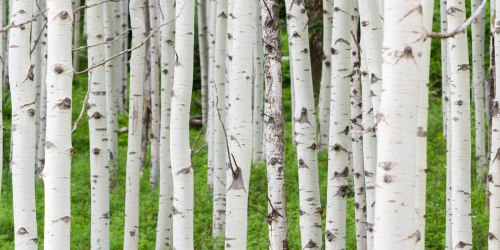Forest Health & Fire Mitigation

Our forests are a valuable resource for Mountain Village. The Town's Planning & Forestry Department is responsible for reviewing all proposed development within town limits to ensure compliance with all fire mitigation and forest health requirements.
Wildfire Mitigation
Property owners should be aware of the following three perspectives when it comes to fire mitigation on their property:
- New construction development is required to have a wildfire mitigation plan as outlined by the Community Development Code. (This activity is not eligible for Defensive Space Incentive Program funding.)
- Mountain Village encourages property owners to voluntarily implement the CDC wildfire mitigation standards (zone 1, 2 and 3 standards - of the CDC). Implementation of these standards may help property owners to reduce their insurance costs.
- For existing properties, please visit our defensible space incentive webpage to learn about financial incentives for creating defensible space around your home.
- To view the latest standards for defensive space wildfire mitigation, please click here.
Our forester is available for a free consultation on forest health, defensible space, hazard trees and forest management. Contact our staff forester Rodney Walters at or call (970) 369-8603.
To learn about our work in 2024, please watch this video below:
Forest Health Initiatives

Aspen Sapling Protection
To protect the aspen saplings, five-foot-tall, light blue grow tubes and protective wire cages are being installed over small aspen trees to protect them until they become tall enough not to be browsed by the elk herd.
Aspen stands can be killed by deer and elk browsing. Protecting the saplings from browse can ensure that aspen stands will be able to regenerate and continue to provide tree benefits in the future.
Please leave them be if you see them throughout Mountain Village.

MCH Packets
If you see a little green packet attached to a tree or stump, this is an MCH packet to repel Douglas fir beetles, and it is supposed to be there. A Douglas fir beetle outbreak occurring down the valley and near Mountain Village has begun affecting Douglas fir trees in Mountain Village.
Douglas fir beetles are a native insect to the Colorado Rocky Mountains and, under normal conditions, generally attack only stressed trees. Under outbreak conditions, however, Douglas fir beetles can indiscriminately attack and kill entire stands of Douglas fir trees. Mountain Village installs MCH packets (an anti-aggregating pheromone) to dissuade beetles from attacking or at least slow the attack rate and preserve the younger Douglas fir trees in Mountain Village. Although MCH packets will not protect all the Douglas fir trees in Mountain Village, the pheromones will help reduce the beetle pressure. The goal is to retain Douglas fir trees on the landscape by keeping enough Douglas fir trees around to reproduce and regenerate once the outbreak has passed.
Although a bit smelly, the MCH packets are a non-toxic way to prevent tree deaths. These packets are like hanging a no vacancy sign on the trees, which tells the beetles that the tree is already occupied and to move on. This confuses the beetles and causes them to fly around, exhaust their energy, and become more vulnerable to predation and mortalities. In this way, MCH packets help to protect Douglas fir trees, especially the smaller Douglas fir trees that are more resilient and less likely to be attacked.
North Boundary, Community-Scale Shaded Fuel Break

North Boundary, Community Scale Shaded Fuel Break project area consists of approximately 100 acres along the top of the steep slope from the Telluride Valley Floor. This shaded fuel break project aims to reduce wildfire intensity, slow the rate of wildfire spread and help protect egress routes, homes, and businesses. The lighter-colored orange areas represent the initial stages of the shaded fuel break area, where work will occur between 2025 and 2028.
The San Miguel County Community Wildfire Protection Plan listed the steep slope between the Telluride Valley Floor and the Town of Mountain Village as a high-risk area that needs to be treated to promote wildfire mitigation. After analyses on the Colorado Wildfire Risk Assessment Portal (COWRAP), approximately 100 acres were strategically selected as a shaded fuel break area. Removal of standing dead and down fuels in conjunction with selective thinning of saplings and budworm-damaged understory ladder fuels with the goals of:
Goals
- Reduce potential fire intensity and severity to make fire more controllable in the treatment area.
- Promote regeneration and continuance of aspen cover.
- Reduce potential fire intensity and severity to make fire more controllable in the treatment area.
- Improve forest health conditions at the individual tree and stand scales.
This fuels reduction and forest health work will make these forest stands more resilient, reduce potential fire intensity and severity, encourage aspen recruitment, and improve forest stand health and vigor. The project will improve the recreational experience along the Meadows, Jurassic and Stegosaurus trails, improve forest health and reduce wildfire risks.
San Miguel County 2019 Forest Assessment
Dr. Jason Sibold has been monitoring and pondering the forest ecology of the Upper San Miguel River Watershed for a decade. Watch Dr. Sibold's 35-minute 2019 update presentation to learn more about the forests and climate of our upper watershed.